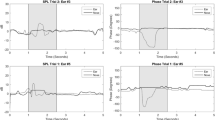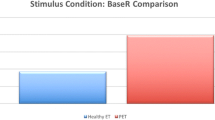Abstract
Sonotubometry is a simple test for Eustachian tube (ET) opening during a maneuver. Different sonotubometry configurations were suggested to maximize test accuracy, but no method has been described for comparing sonotubometry test results with those for a definitive measure of ET opening. Here, we present such a method and exemplify is use by an accuracy assessment of a simple sonotubometry configuration. A total of 502 data-sequences from 168 test sessions in 103 adult subjects were analyzed. For each session, subjects were seated in a pressure chamber and relative middle ear over- and under-pressures created by changing chamber pressure. At each pressure, the test sequence of bilateral tympanometry, bilateral sonotubometry while the subject swallowed twice, and bilateral tympanometry was done. Tympanometric data were expressed as the fractional gradient equilibrated (FGE) by swallowing and sonotubometric signals were analyzed to record the shape of detected sound signals. Tympanometric and sonotubometric tubal opening assignments were analyzed by cross-correlation. For the data sequences with FGE = 0 (n = 32) evidencing no tubal opening and one (n = 249) evidencing definitive tubal opening, detection of a sonotubometry sound signal during a swallow had a sensitivity and specificity of 74.2 and 65.6 % for identifying ET openings and an accuracy of 73.3 % for assigning ET opening/non-opening by swallowing. Measures of sound signal shape were significantly different between those groups. This protocol allows a sonotubometry accuracy assessment for detecting ET openings. For the test configuration used, accuracy was moderate, but this should improve as more sophisticated sonotubometry test configurations are evaluated.



Similar content being viewed by others
References
Bluestone CD (2005) Eustachian tube structure, function, role in otitis media. BC Decker Inc, Hamilton
Doyle W (2000) Middle ear pressure regulation. In: Rosowski J, Merchant S (eds) The function and mechanics of normal, diseased and reconstructed middle ears. Kugler Publications, The Hague
Andreasson L, Ivarsson A, Luttrup S, Mollerstrom B, Tjernstrom O (1984) Eustachian tube function measured as pressure equilibration and sound transmission capacity. A comparison in healthy ears. ORL J Oto-Rhino-Laryngol Relat Spec 46(2):74–83
Virtanen H (1978) Sonotubometry. An acoustical method for objective measurement of auditory tubal opening. Acta Otolaryngol 86(1–2):93–103
Politzer A (1883) The diseases of the ear and adjacent organs (trans: Cassells JP). Bailliere, Tindall and Cox, London, p 71
Perlman HB (1939) The Eustachian tube: abnormal patency and normal physiologic state. Arch Otolaryngol 30:212–238
Perlman HB (1951) Observations on the Eustachian tube. AMA Arch Otolaryngol 53(4):370–385
Elpern BS, Naunton RF, Perlman HB (1964) Objective measurement of middle ear function: the Eustachian tube. Laryngoscope 74:359–371. doi:10.1288/00005537-196403000-00003
Satoh I, Watanabe I, Sainoo T (1970) Measurement of Eustachian tube function. Arch Otolaryngol 92(4):329–334
Holmquist J, Bjorkman G, Olen L (1981) Measurement of Eustachian tube function using sonotubometry. Scand Audiol 10(1):33–35
Lildholdt T, Brask T, Hvidegaard T (1984) Interpretation of sonotubometry. A critical view of the acoustical measurement of the opening of the Eustachian tube. Acta Otolaryngol 98(3–4):250–254
Munro KJ, Benton CL, Marchbanks RJ (1999) Sonotubometry findings in children at high risk from middle ear effusion. Clin Otolaryngol Allied Sci 24(3):223–227
Doyle WJ, Seroky JT, Angelini BL, Gulhan M, Skoner DP, Fireman P (2000) Abnormal middle ear pressures during experimental influenza A virus infection—role of Eustachian tube function. Auris Nasus Larynx 27(4):323–326
Palva T, Marttila T, Jauhiainen T (1987) Comparison of pure tones and noise stimuli in sonotubometry. Acta Otolaryngol 103(3–4):212–216
Jonathan D (1990) The predictive value of Eustachian tube function (measured with sonotubometry) in the successful outcome of myringoplasty. Clin Otolaryngol Allied Sci 15(5):431–434
Murti KG, Stern RM, Cantekin EI, Bluestone CD (1980) Sonometric evaluation of Eustachian tube function using broadband stimuli. Ann Otol Rhinol Laryngol Suppl 89(3 Pt 2):178–184
van der Avoort SJ, van Heerbeek N, Snik AF, Zielhuis GA, Cremers CW (2007) Reproducibility of sonotubometry as Eustachian tube ventilatory function test in healthy children. Int J Pediatr Otorhinolaryngol 71(2):291–295. doi:10.1016/j.ijporl.2006.10.015
Jonathan DA, Chalmers P, Wong K (1986) Comparison of sonotubometry with tympanometry to assess Eustachian tube function in adults. Br J Audiol 20(3):231–235
Morita M, Matsunaga T (1993) Sonotubometry with a tubal catheter as an index for the use of a ventilation tube in otitis media with effusion. Acta Oto-Laryngologica Suppl 501:59–62
Di Martino EF, Thaden R, Antweiler C, Reineke T, Westhofen M, Beckschebe J, Vorlander M, Vary P (2007) Evaluation of Eustachian tube function by sonotubometry: results and reliability of 8 kHz signals in normal subjects. Eur Arch Oto-Rhino-Laryngol Head Neck Surg 264(3):231–236. doi:10.1007/s00405-006-0172-1
Leider J, Hamlet S, Schwan S (1993) The effect of swallowing bolus and head position on Eustachian tube function via sonotubometry. Otolaryngol Head Neck Surg 109(1):66–70
van der Avoort SJ, Heerbeek N, Zielhuis GA, Cremers CW (2006) Validation of sonotubometry in healthy adults. J Laryngol Otol 120(10):853–856. doi:10.1017/s0022215106001095
Di Martino EF, Nath V, Telle A, Antweiler C, Walther LE, Vary P (2010) Evaluation of Eustachian tube function with perfect sequences: technical realization and first clinical results. Eur Arch Otorhinolaryngol 267(3):367–374. doi:10.1007/s00405-009-1074-9
Asenov DR, Nath V, Telle A, Antweiler C, Walther LE, Vary P, Di Martino EF (2010) Sonotubometry with perfect sequences: first results in pathological ears. Acta Otolaryngol 130(11):1242–1248. doi:10.3109/00016489.2010.492481
van Heerbeek N, van der Avoort SJ, Zielhuis GA, Cremers CW (2007) Sonotubometry: a useful tool to measure intra-individual changes in Eustachian tube ventilatory function. Arch Otolaryngol Head Neck Surg 133(8):763–766. doi:10.1001/archotol.133.8.763
McBride TP, Derkay CS, Cunningham MJ, Doyle WJ (1988) Evaluation of noninvasive Eustachian tube function tests in normal adults. Laryngoscope 98(6 Pt 1):655–658. doi:10.1288/00005537-198806000-00015
Virtanen H, Palva T, Jauhiainen T (1980) Comparative preoperative evaluation of Eustachian tube function in pathological ears. Ann Otol Rhinol Laryngol 89(4 Pt 1):366–369
Iwano T, Ushiro K, Yukawa N, Doi T, Kinoshita T, Hamada E, Kumazawa T (1993) Active opening function of the human Eustachian tube: comparison between sonotubometry and pressure equilibration test. Acta Oto-Laryngol Suppl 500:62–65
Murti KG, Stern RM, Cantekin EI, Bluestone CD (1982) Classification of spectral patterns obtained from Eustachian tube sonometry. IEEE Trans Bio-Med Eng 29(6):472–477. doi:10.1109/tbme.1982.324978
Acknowledgments
This study was supported in part by a Grant from the National Institutes of Health (P50 DC007667), and by the Hamburg and Eberly Endowments to the Division of Pediatric Otolaryngology, University of Pittsburgh. These sources provided funding for the study but did not have input into the study design or the analyses and interpretation of the data.
Conflict of interest
None of the authors has a real or potential conflict of interest to declare regarding the materials presented in this manuscript.
Author information
Authors and Affiliations
Corresponding author
Rights and permissions
About this article
Cite this article
Swarts, J.D., Teixeira, M.S., Banks, J. et al. A method to assess the accuracy of sonotubometry for detecting Eustachian tube openings. Eur Arch Otorhinolaryngol 272, 2111–2119 (2015). https://doi.org/10.1007/s00405-014-3031-5
Received:
Accepted:
Published:
Issue Date:
DOI: https://doi.org/10.1007/s00405-014-3031-5




